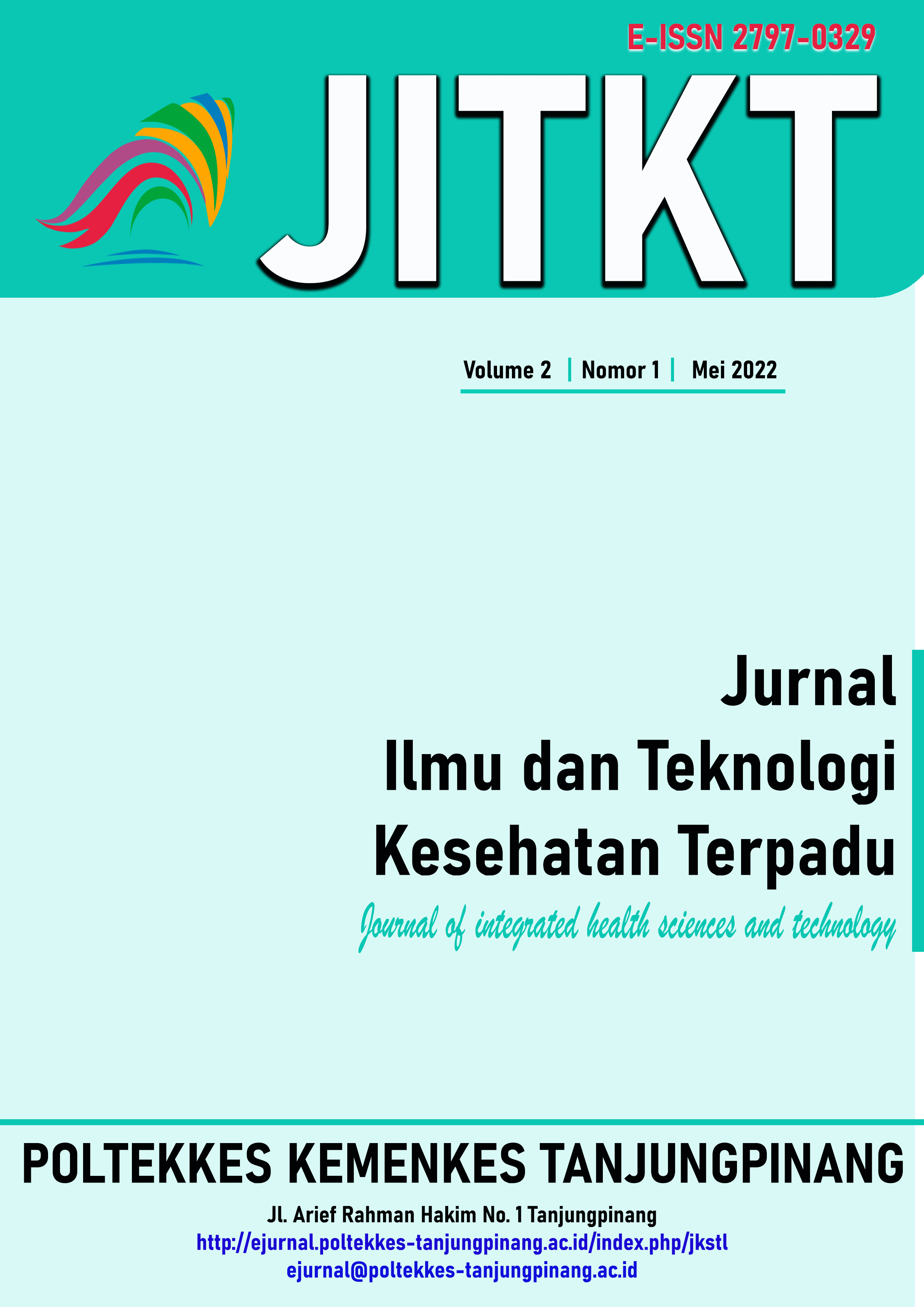INDEKS ENTOMOLOGI DAN SEBARAN VEKTOR NYAMUK Aedes spp DI KELURAHAN PINANG KENCANA KECAMATAN TANJUNGPINANG TIMUR KOTA TANJUNGPINANG, KEPULAUAN RIAU
Entomology Index and Aedes Spp Mosquito Vector Distribution in Kelurahan Pinang Kencana Sub-District Tanjungpinang Timur City of Tanjungpinang, Riau Island
Keywords:
Aedes spp, Indeks Entomologi, Kepadatan Nyamuk, sebaran DBDAbstract
Dengue hemorrhagic fever (DHF) is a disease that is still a health problem in Indonesia caused by the dengue virus and is transmitted through the Aedes spp mosquito as the main vector that causes this disease. Tanjungpinang Timur District since January-December 2020 in the Pinang Kencana Village has recorded 52 positive right. The type and design of this study used observational research by conducting a descriptive analysis survey with a cross sectional study approach, the variables studied were the entomological index and the distribution of the Aedes spp mosquito vector. How to collect data by surveying larvae and taking the coordinates of the houses of DHF sufferers and their surrounding houses. The results of this study show that as many as 100 houses were surveyed, the House Index (HI) was 28%, the Container Index (CI) was 14% and the Breteau Index (BI) was 33%. The distribution of the presence of Aedes spp mosquito larvae is based on the coordinates of the house of dengue cases adjacent to the positive house of Aedes spp mosquito larvae in Pinang Kencana Village, Tanjungpinang Timur District. The conclusion of this study, based on the results of the entomological index, obtained a Density Figure (DF) in Pinang Kencana Village with a medium density category. Suggestions for the community to more attention cleanliness of controllable containers. Containers are most found larvae is bucket containers inside house and bottle containers outside house. Suggestions for health agencies can be a reference in vector control and can further mobilize Mosquito Nest Eradication (MNE) and 3M Plus in Pinang Kencana Village, Tanjungpinang Timur District.
Downloads
References
Dinas Kesehatan Provinsi Kepulauan Riau. Profil Kesehatan Kepulauan RIau. Tanjungpinang; 2018.
Young KI, Mundis S, Widen SG, Wood TG, Tesh RB, Cardosa J, et al. Abundance and distribution of sylvatic dengue virus vectors in three different land cover types in Sarawak, Malaysian Borneo. Parasites and Vectors. 2017;10(1):1–14.
Khetarpal N, Khanna I. Dengue Fever: Causes, Complications, and Vaccine Strategies. J Immunol Res. 2016;2016(3).
Riandi MU, Ipa M, Hendri J. Sebaran Jentik Nyamuk Aedes spp di Kecamatan Tawang Kota Tasikmalaya. Rumusan Strateg Kesehat dan Pertan dalam Percepatan Pengentasa Kemiskin Menuju Tercapainya Target MDGs 2015 [Internet]. 2012;(Juli):141–51. Available from: https://www.researchgate.net/publication/257928815_Sebaran_Jentik_Nyamuk_Aedes_spp_di_Kecamatan_Tawang_Kota_Tasikmalaya
Kementerian Kesehatan. Profil Kesehatan Indonesia 2014. Vol. 51, Kementerian Kesehatan Republik Indonesia. 2015. 99 p.
Dinas Kesehatan Kota Tanjungpinang. Profil Kesehatan Kota Tanjungpinang. Tanjungpinang; 2019.
Prasetyowati H, Ginanjar A. Maya Indeks dan Kepadatan Larva Aedes Aegypti di Daerah Endemis DBD Jakarta Timur. Vektora [Internet]. 2017;9(1):43–9. Available from: https://media.neliti.com/media/publications/127371-ID-gambaran-maya-indeks-dan-kepadatan-larva.pdf
Astuti EP, Heni Prasetyowati D, Ginanjar A. Risiko Penularan Demam Berdarah Dengue berdasarkan Maya Indeks dan Indeks Entomologi di Kota Tangerang, Banten. Media Litbangkes. 2016;26(4):211–8.
Maryanti E, Ismawati I, Prissilia U, Puteri AY. Potensi Transmisi Demam Berdarah Dengue Berdasarkan Indeks Entomologi dan Maya Indeks di Tiga Kelurahan Kecamatan Sukajadi Kota Pekanbaru. J Kesehat Lingkung Indones. 2020;19(2):111–8.
Sunaryo S, Pramestuti N. Surveilans Aedes aegypti di Daerah Endemis Demam Berdarah Dengue. Kesmas Natl Public Heal J. 2014;8(8):423.
Oktaviani V, Ariyani S, Krisdiyanta. Pemetaan Epidemiologi Sebaran Penderita Demam Berdarah Dengue di Kecamatan Kota Baru Kota Jambi Tahun 2015. J Poltekkes Jambi. 2016;13(5):248–58.
Soenjono SJ, . S, Sambuaga JVI. Pemetaan Resistensi Nyamuk Aedes sp Terhadap Malation dan Kepadatan Vektor Demam Berdarah Dengue (DBD) di Sulawesi Utara. J Sehat Mandiri. 2020;15(1):1–7.
Taslisia T, Rusdji SR, Hasmiwati H. Survei Entomologi, Maya Indeks, dan Status Kerentanan Larva Nyamuk Aedes aegypti terhadap Temephos. J Kesehat Andalas. 2018;7(1):33.
Nofita, Eka, Hasmiwati, Selfi Renita Rusdji NI. Analysis of indicators entomology Aedes aegypti in endemic areas of dengue fever in Padang, West sumatra, Indonesia. Int J Mosq Res. 2017;4(2):57–9.
Ferede G, Tiruneh M, Abate E, Kassa WJ, Wondimeneh Y, Damtie D, et al. Distribution and larval breeding habitats of Aedes mosquito species in residential areas of northwest Ethiopia. Epidemiol Health. 2018;40:e2018015.
Khairunisa U, Wahyuningsih NE, Hapsari. Kepadatan Jentik Nyamuk Aedes Sp. (House Index) Sebagai Indikator Surveilans Vektor Demam Berdarah Dengue Di Kota Semarang. J Kesehat Masy. 2017;5(5):906–10.
Ramlawati, Ibrahim E, Selomo M. Hubungan Pelaksanaan PSN 3M Dengan Densitas Larva Aedes aegypti di Wilayah Endemis DBD Makassar. Universitas Hasanuddin; 2014.
Dhewantara PW, Dinata A. the Maya Index Analysis on Dengue Patient Household in Banjar City, 2012. Balaba J Litbang Pengendali Penyakit Bersumber Binatang Banjarnegara. 2015;11(1):1–8.
Budiyanto A. Karakteristik kontainer terhadap keberadaan jentik Aedes aegypti di Sekolah Dasar. J Pembang Mns. 2012;6(1):1–9.
Novasari AM, Sasongkowati R. The Effect of Sugar Apple (Annona squamosa L.) Seeds Solution as an Insecticide Against Mortality of Aedes aegypti Mosquito with Liquid Electric Method. J Kesehat Lingkung. 2018;9(2):200.
Hermansyah. Model Manajemen Demam Berdarah Dengue; Suatu Analisis Spasial Pascatsunami Di Wilayah Kota Banda Aceh. Disertasi. 2012;234.
Published
How to Cite
Issue
Section
Copyright (c) 2022 JURNAL ILMU DAN TEKNOLOGI KESEHATAN TERPADU

This work is licensed under a Creative Commons Attribution-NonCommercial-ShareAlike 4.0 International License.












